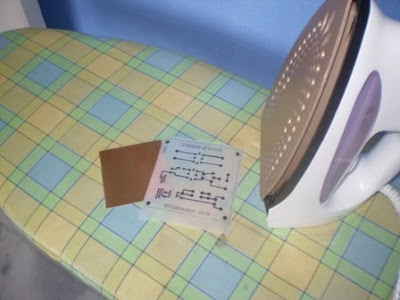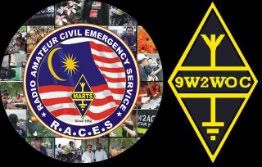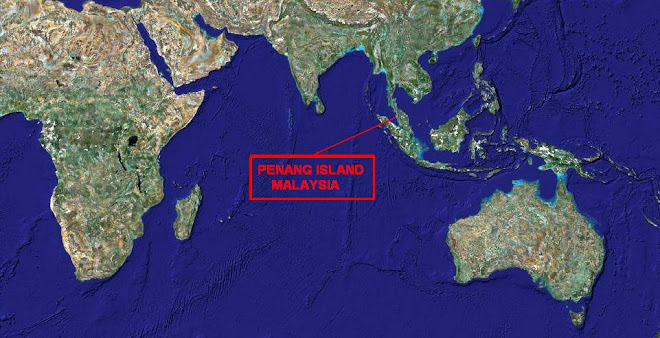MARTS - RACES BRIEFING, DEMO DRILL & BASIC TRAINING.
QTH : SEMARAK RESORT, SUNGAI BATU PAHAT, PERLIS. ( N 06 30' 34 " E 100 10' 37" )
DATE : 22 & 23 HB. NOVEMBER 2008
TIME : 8PM - 11PM DAY 1 & 8AM - 12AM DAY 2
DAY 1
8:00PM ARRIVAL OF PARTICIPANTS
8:30PM SESSION 1 : TOPIC - RACES - WHAT IT IS?
9:00PM SESSION 2 : TOPIC - RACES - BASIC PREPARATION (STATION SET-UP)
9:30PM SESSION 3 : TOPIC - RACES - TRAFFIC/MSG HANDLING
10:15PM SESSION 4 : TOPIC - MSG FORM/LOG
11:00PM SESSION 5 : RAG CHEW SESSION
DAY 2
08:00AM BREAKFAST
08:30AM SESSION 6 : RACES ACTIVATION
08:40AM SESSION 7 : STATION DEPLOYMENT
09:15AM SESSION 8 : STATION ROLL-CALL
09:30AM SESSION 9 : TRAFFIC HANDLING ( RACES OPERATED )
10:30AM SESSION 10 : RACES DEACTIVATE
10:45AM SESSION 11 : Q & A ( RAG CHEW )
12:00AM CHECK OUT
01:00PM LUNCH
03:00PM DEPLOYMENT OF RACES TEAM TO UUM SINTOK
04:00PM MEETING WITH ITU, IARU AND ORGANISER.
NOTE :
1. PLEASE BRING ALONG YOUR OWN APPARATUS ( EQUIPMENT )
2. BE PREPARED FOR WEATHER CHANGE - RAIN & HOT SUN.
3. ENOUGH POWER SUPPLY. I.E: STANDBY BATTERY/SOLAR PANEL/ETC.
4. SAFETY! SAFETY! SAFETY!
GOOD LUCK!!!...
Penang Bridge International Marathon 2008
1. First time ever there's NO vehicle on the Longest (Penang Bridge) :P



4. This is our station setup at 20ft height antenna.
5. Our station centre.
6. Checkin with Base control for signal report.

7. Brake time QSO with other station.

ITU Asia-Pacific Centres of Excellence Training Workshop on Effective Use of Telecommunications/ICT in Response to Disasters: Saving Lives
24-28 November 2008.
International Telecommunication Union (ITU), with financial support from the Department of Broadband, Communications and the Digital Economy (DBCDE), Australian Government, and jointly with the ITU ASP Centre of Excellence (CoE) Network UUM Node in Malaysia, and the Ministry of Energy, Water and Communications (MEWC), Government of Malaysia, is organizing a five-day “ITU Asia-Pacific Centres of Excellences Training Workshop on Effective Use of Telecommunications/ICT in Response to Disasters: Saving Lives". The Training Workshop will provide hands-on training on deployment and use of various telecommunication/ICT equipment and facilities such as satellite terminals, amateur radio, ad-hoc wireless networks, and VSAT. The training will also focus on vital ICT applications such as GIS and tele-medicine used in relief operations.
The Training Workshop focuses on concepts and hands-on training on various technologies and applications applicable and suitable for deployment aiming at facilitating rescue and relief operations in emergencies and especially in the aftermath of disasters. The Training Workshop aims to:
*Make awareness and demonstrate telecommunication technology options, facilities and services applicable for use in response to disasters or emergencies especially in disaster relief operations;
*Provide practical experience to participants in using the telecommunication/ICT facilities and services for disaster relief operations;
*Strengthen partnerships in disaster relief among international agencies/organizations, NGOs, Industry, and governments as well as encourage roles of public sector or NGOs e.g. radio amateurs, volunteers, etc.; and,
*Identify issues, gaps in countries in order to find ways for improvements or overcoming the issues or challenges.
Country delegates are invited to contribute country papers and presentations which will be presented and discussed during the course, by e-mail to Mr. Wisit Atipayakoon ( wisit.atipayakoon@itu.int ). The papers or presentations should address, but not limited to:
1. Nature of disasters and socio-economic impact.
2. Issues and challenges in applying telecommunications/ICTs for all phases of disaster management.
3. Existence of policy, regulation, and plan concerned to communications for emergencies and disasters.
4. Recommendations for action plans and ways forwards.
To register for the Training Workshop, participants are kindly requested to complete the attached registration form and send it to wisit.atipayakoon@itu.int by 7 November 2008 at the latest. ITU will provide one full fellowship covering air ticket and daily subsistence allowance (DSA), to ITU Member Administrations or authorized nominations. Kindly fill in the attached fellowship request form with all complete details and send it with your registration form. Due to limited seats and budget availability, the fellowships will be awarded on a first come first served basis and priority shall be given to Least Developed Countries and Low-Income Developing Countries and to candidates submitting a country paper or presentation for the workshop.
There are no training fees for this Training Workshop. Please contact wisit.atipayakoon@itu.int with any general queries you may have related to this event.
ITU is inviting sponsors for the Training Workshop. The sponsors may lend equipment or services, applications for demonstration and hands-on training, or may provide experts to the Training Workshop. These can be, but not limited to:
*VSAT system
*HF/VHF/UHF radio equipment
*Satellite phones and/or satellite broadband terminals (with airtime)
*Wi-Fi / Wi-Max demo
*Satellite applications e.g. remote sensing demo, GIS, etc.
*Telemedicine application
Stellite Phone Scenario


VSAT Network Scenario

Wireless Network Scenario

All MARTS members be prepare for this Training, especially RACES Team.
All info taken from ITU web http://www.itu.int/ITU-D/asp/CMS/Events/2008/DisasterComm.asp
ICOM OPC-478 Data Cable Replacement (Homebrew).
 recently managed to get hold of (at very reasonable cost) an ICOM IC-F4GS PMR Radio (2-way walkie talkie) which had previously been used for (what I would imagine to be) nightclub security. No-doubt the bouncer who owned this had swapped it for a lightweight unit and an earpiece. The radio had three programmed frequencies.
recently managed to get hold of (at very reasonable cost) an ICOM IC-F4GS PMR Radio (2-way walkie talkie) which had previously been used for (what I would imagine to be) nightclub security. No-doubt the bouncer who owned this had swapped it for a lightweight unit and an earpiece. The radio had three programmed frequencies.So I have this great ICOM radio - Wow! Now what? Only having three channels programmed into it on unknown frequencies makes it pretty useless. So . . . I wanted to be able to re-program this radio for my own use on PMR446, and also perhaps the 70cm Amateur Bands.These radios are not programmable using the buttons on the front - You must program them using a PC, with specific software and a suitable cable.
The correct data cable for this radio (and for the IC-F3 radios too) was the OPC-478. I didn't fancy buying this cable. Getting it shipped over from a seller in China would cost £20-£25 (and a lot more it I got it from an official Icom retailer!) so I thought I would have a go at making the link cable myself.
Here is the circuit I used, with connection notes for a DB9, 9 pin serial plug.

The Data connection to the ICOM radio is via a 3.5mm Stereo socket, which is also used as the speaker / headphone socket. As you can see, the centre 'ring' of the plug is used as the data ('To Radio') and the connection to Ground is the outer. The centre 'top' pin is not used.
 Similar to the Port Keyer that I had already built, I decided to build the entire circuit so it would fit neatly into the DB9 plastic housing. I knew that this would not be a straightforward exercise due to the amount of components I would need to fit into such a small space.
Similar to the Port Keyer that I had already built, I decided to build the entire circuit so it would fit neatly into the DB9 plastic housing. I knew that this would not be a straightforward exercise due to the amount of components I would need to fit into such a small space.
To save space, I decided to mount the two capacitors on the reverse side of the board.

Just for accuracy and completeness of the notes on this Webpage, it is worth pointing out that I exchanged the 1uF DC smoothing capacitor in the circuit for a 0.47uF one. This was due to not being able to fit a 1uF Electrolytic easily in the package. I also exchanged the 2, 33K resistors for 22K ones. This was just due to me having some spare miniature 22K resistors. These form the potential divider to Q1 and are not critical values.

I had to cut, trim, and melt the inside area of the plastic housing so that this circuit board would fit into it.The two parts of the housing would then be glued together.

As for the software needed - The correct software to use is ICOM's CS-F3G program (CSF3G).Here is the screen display of the software with the 8 Standard PMR channels programmed in.Note that the software is copyright and the property of ICOM. It is, however, available in several locations on the Internet.

NOTE:
Works great with all OPC-478 compatible radios such as; IC-A110, IC-A23, IC-A24, IC-A4, IC-A5, IC-A6, IC-E208, IC-E90, IC-T2A/H, IC-T3H, IC-T7A/H, IC-T8A, IC-T81A/E, IC-T90A, IC-V8/A, IC-V80, IC-V82, IC-V85, IC-U82, IC-W32A/EIC-208E/H, IC-2100H, IC-2200H, IC-2720H, IC-2725E, IC-2800H, IC-V8000, IC-3FGX, IC-40S, IC-F10, IC-F11, IC-F12, IC-F1020, IC-F20, IC-F21, IC-F22, IC-F3GT/GS, IC-F4GT/GS, IC-R10, IC-R2, IC-R3, IC-R5 and more....
Computer control cable for ICOM rigs. With this cable, you can control your ICOM radio from your PC!
All my source here comes from: http://www.geocities.com/wight446/opc478.htm
Thank you, remote your radio. :p
Model with a ICOM V85 HT



Ham Radio Deluxe By 9W2AZV

Ham Radio Deluxe (HRD) ada la satu software percuma untuk windows, program ini menyediakan kawalan computer yang kebiasanya digunakan oleh radio HF. Ham Radio Dulux juga disertakan dengan peta, statellite tracking dan juga digital mode yang lain iaitu Digital Master 780 (DM780) anda boleh muat turun software ini disini .
Untuk tutorial kali ini saya lebih menumpukan kepada software Digital Master 780 yang di sertakan sekali di dalam package HRD ini. Memandangkan kebanyakan rakan amatur di Malaysia ini tidak memiliki Rig HF yang ada dalam senarai software, ini tidak bermakna anda ketinggalan untuk turut serta dalam mode digital di jalur VHF.
Untuk pengetahuan anda band plan amateur 144.000Mhz - 148.000Mhz telah memperuntukan sedikit ruang untuk kita mencuba mode digital ini, yang selalunya sunyi dari kita gunakan berikut adalah chanel list band plan digital yang digunakan di Malaysia.

Warna merah adalah mode digital
Digital Master 780.Digital Master 780 adalah sebuah multi mode digital program yang disertakan dengan mode:
-PSK, QPSK, CW, Domino EX, HELL, MFSK, MT63, OLIVIA, RTTY, THROB
-Buku log elektronik
-Skinning
-Super browser yang memaparkan semua jejak PSK didalam satu Windows
-SSTV dengan mode Scottie dan Martin (lain-lain mode akan ditambah selepas ini)
Fokus utama kita sekarang ni adalah untuk menjalankan software ini untuk radio yang selalu dimiliki oleh operator radio di Malaysia seperti Rig Icom IC- 2200H, Yeasu FT 7800 dan lain-lain lagi.
Peralatan yang perlu anda sediakan.
Anda hanya perlu sediakan adalah sebuah rig atau handy, Antenna tinggi secukup rasa, PC atau notebook tidak mermerlukan Com Port dan sebuah Interface yang dibuat sendiri.
Interface.
Interface anda homebrew sendiri pon boleh atau cari rakan yang boleh buat untuk anda. Disini saya lampirkan sebuah litar yang paling mudah untuk anda buat interface.
Komponen yang perlu anda sediakan.
* 2 x (T1 & T2) 600 Ohm transformers type 9000 RS Number 208-822
* In meter run Screened Cable
* 1x Project Box
* 1x Push on Switch Push Off
* 3x Stereo Jack


Bersambung.....more detail logon to http://perlis.marts.org.my/
Part 2 [FINAL] : Homebrew a Sound Card Interface (Digital Mode)
1.

2.

3.

4.

5.

6.

7.

8.

9.

10.

11.

12.

Here we go, the full digital interface in a box...once you plug it the connector you no need to unplug it anymore from your rig. Its only using a switch to change it your digital mode to a FM mode. Terima kasih.
ENJOY...:P
NOTE : Sorry if I not put in any description on this project, too lazy to type..lol.
JUST WAIT FOR MY NEXT PROJECT!!!









